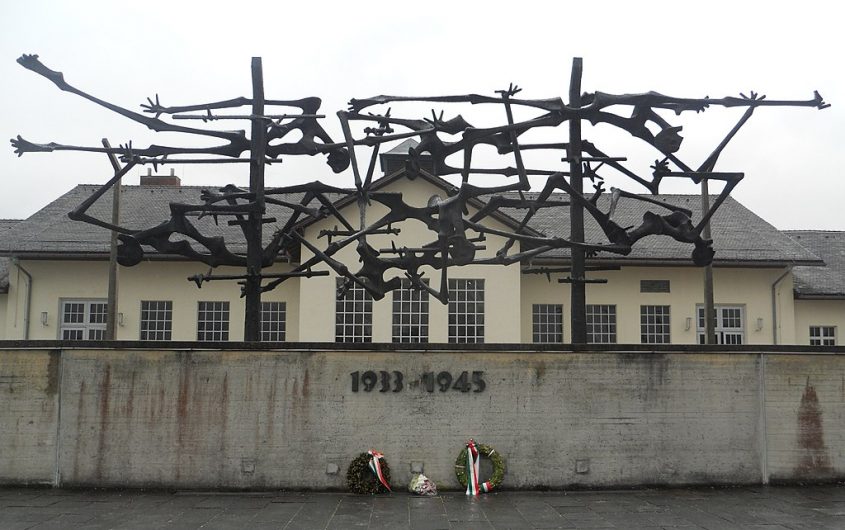
Erik Drost via Wikimedia Commons
Language of Remembrance

Matthieu Liebman
Mr. Matthieu Liebman is a research intern at AICGS for the spring of 2022. His duties include conducting research for resident fellows and projects, managing databases, and helping to organize and document events at AICGS.
Mr. Liebman is currently pursuing a BA in German at Georgetown University, where he also plans to complete a certificate in European Studies. His research interests center on memory politics and the culture of remembrance in Germany and Europe.
Aside from his academic pursuits, Mr. Liebman enjoys learning new languages. In addition to German, he has studied Polish at Georgetown and is currently learning Swedish and Finnish. He also likes to travel and experience different cultures. In 2018, Mr. Liebman traveled to Germany as a recipient of the AATG/Pädagogischer Austauschdienst Study Trip Award.
Over the last few years, American society has been entrenched in a debate about how to remember the past. Demonstrations calling for the removal of Confederate statues and the backlash against those calls have dominated the headlines. More recently, a statue of President Theodore Roosevelt that had stood in front of New York City’s Natural History Museum for decades was taken down. The statue, which depicts Roosevelt on horseback towering over a Native American and a Black man, has long been the subject of controversy: does the statue honor Roosevelt’s legacy, or does it depict the President as “superior” to the Indigenous and African men on either side of him?
While a similar debate persists in Germany pertaining to representations of the country’s colonial past, Holocaust memorials are hardly contested. In fact, Germany’s Erinnerungskultur (culture of remembrance) is widely viewed as a model for how a country might remember its dark past. But why have the Germans had so much success with Holocaust remembrance? One might point to a number of different reasons, such as a collective sense of guilt or maybe a feeling of responsibility to the victims to ensure they are not forgotten. There might also be a linguistic element to this success; that is, the German and English languages may contribute to the fostering or hindering of a successful culture of remembrance in Germany and the United States, respectively.
Part of the debate surrounding Confederate monuments in the United States revolves around what they actually mean. Similar to the question of whether the Roosevelt statue represented his legacy of conservation or implied a racial hierarchy, the debate arises as to whether Confederate monuments celebrate and honor the Confederacy or represent a dark period in American history. This informs the debate regarding the removal of a monument: those who view it as a celebration of the Confederacy might want it taken down, while others may believe it acts as a symbol of heritage (in line with the “Lost Cause” myth), or that it serves as a tool to educate people about the past, making it important to leave up. The English language does not help in this complicated debate; the words monument and memorial are seemingly ambiguous terms; neither explicitly expresses the intent behind the site to which it refers. Thus, when attributing these words to a specific site or statue, there is room for interpretation as to what these sites or statues actually represent. For example, a Confederate monument might evoke positive or neutral emotions for one individual but negative emotions for another. Since monument does not indicate whether the intent is to honor, admonish, or educate about the past, it is left to the viewer to interpret the meaning of the site. As such, the English language could be seen as contributing to division regarding how the past should be remembered in the United States.
These German words, Ehrenmal, Denkmal, and Mahnmal thus enable the expression of the intention behind a monument or memorial in a way that English cannot.
German, on the other hand, provides a means to expressly indicate the intention behind a monument or memorial. One has a variety of words to choose from in the German language when it comes to these sites. Three notable words are Ehrenmal, Denkmal, and Mahnmal. Unlike the English monument and memorial, these German words, which do not have English equivalents, have different connotations, enabling them to not only signify that a site or statue is a monument or memorial, but also to imply the meaning behind it. An Ehrenmal can be interpreted as a monument that “honors” (ehren: to honor) a historical event. For example, the Sowjetisches Ehrenmal (Soviet Memorial) in Berlin “honors” the Soviet soldiers who fought and died in the Battle of Berlin in 1945. A Denkmal (denken: to think) is a monument or memorial that acknowledges something that happened in the past; it promotes thinking or reflection. The Denkmal für die ermordeten Juden Europas (Memorial for the Murdered Jews of Europe) in Berlin recognizes the millions of Jews murdered by the Nazis during the Holocaust. The fact that this memorial is referred to as a Denkmal indicates that it serves to remember the Jews who were murdered rather than the actual acts and events that caused their deaths. Such a memorial, one that not only acknowledges horrific events and atrocities but serves to admonish them, is called a Mahnmal (mahnen: to admonish). The Internationales Mahnmal (International Monument) at the Dachau Concentration Camp is referred to as such because it is a site intended to admonish the atrocities that occurred there. These German words, Ehrenmal, Denkmal, and Mahnmal thus enable the expression of the intention behind a monument or memorial in a way that English cannot.
In providing less room for debate as to what monuments and memorials actually serve to do, the German language helps Germany to better manage a similar debate to that in the United States, contributing to a more successful German Erinnerungskultur.






